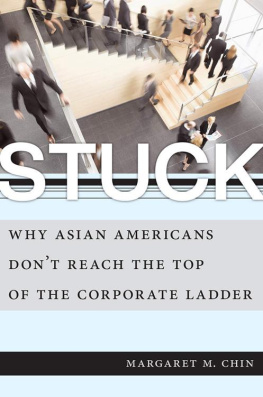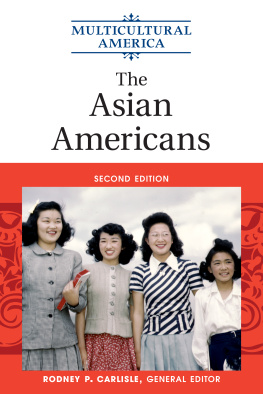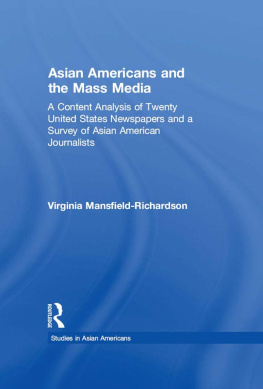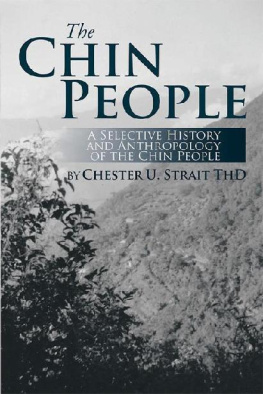Margaret M. Chin - Stuck: Why Asian Americans Dont Reach the Top
Here you can read online Margaret M. Chin - Stuck: Why Asian Americans Dont Reach the Top full text of the book (entire story) in english for free. Download pdf and epub, get meaning, cover and reviews about this ebook. year: 2020, publisher: NYU Press, genre: Politics. Description of the work, (preface) as well as reviews are available. Best literature library LitArk.com created for fans of good reading and offers a wide selection of genres:
Romance novel
Science fiction
Adventure
Detective
Science
History
Home and family
Prose
Art
Politics
Computer
Non-fiction
Religion
Business
Children
Humor
Choose a favorite category and find really read worthwhile books. Enjoy immersion in the world of imagination, feel the emotions of the characters or learn something new for yourself, make an fascinating discovery.
- Book:Stuck: Why Asian Americans Dont Reach the Top
- Author:
- Publisher:NYU Press
- Genre:
- Year:2020
- Rating:5 / 5
- Favourites:Add to favourites
- Your mark:
- 100
- 1
- 2
- 3
- 4
- 5
Stuck: Why Asian Americans Dont Reach the Top: summary, description and annotation
We offer to read an annotation, description, summary or preface (depends on what the author of the book "Stuck: Why Asian Americans Dont Reach the Top" wrote himself). If you haven't found the necessary information about the book — write in the comments, we will try to find it.
Stuck: Why Asian Americans Dont Reach the Top — read online for free the complete book (whole text) full work
Below is the text of the book, divided by pages. System saving the place of the last page read, allows you to conveniently read the book "Stuck: Why Asian Americans Dont Reach the Top" online for free, without having to search again every time where you left off. Put a bookmark, and you can go to the page where you finished reading at any time.
Font size:
Interval:
Bookmark:
Margaret M. Chin

NEW YORK UNIVERSITY PRESS
New York
NEW YORK UNIVERSITY PRESS
New York
www.nyupress.org
2020 by New York University
All rights reserved
References to Internet websites (URLs) were accurate at the time of writing. Neither the author nor New York University Press is responsible for URLs that may have expired or changed since the manuscript was prepared.
Library of Congress Cataloging-in-Publication Data
Names: Chin, Margaret May, 1962 author.
Title: Stuck : why Asian Americans dont reach the top of the corporate ladder / Margaret M. Chin.
Description: New York : New York University Press, 2020. | Includes bibliographical references and index.
Identifiers: LCCN 2019043223 | ISBN 9781479816811 (cloth) | ISBN 9781479842766 (paperback) | ISBN 9781479873807 (ebook) | ISBN 9781479845682 (ebook)
Subjects: LCSH : Leadership. | Asian AmericansEducation. | Asian AmericansPsychology. | Affirmative action programs.
Classification: LCC HM1263 .C45 2020 | DDC 305.895/073dc23
LC record available at https://lccn.loc.gov/2019043223
New York University Press books are printed on acid-free paper, and their binding materials are chosen for strength and durability. We strive to use environmentally responsible suppliers and materials to the greatest extent possible in publishing our books.
Manufactured in the United States of America
10 9 8 7 6 5 4 3 2 1
Also available as an ebook
To Perry, Alex, and Meredithwho keep me laughing and grounded
A T a 2013 reception at the New York Harvard Club for newly admitted students, an event at which perhaps half of those attending appeared to be Asian Americans, because they brought their many proud relatives, an admissions officer said to me, only half joking, that since 1980 the college had admitted and graduated thousands of second-generation Asian Americans and added, Where are they? Why arent they at the top? In other words, why werent Asian Americans among the elite professionals in corporate America? Why werent they occupying the so-called C-suites, the traditional province of senior executives?
Harvards admissions team has always believed that the students admitted by the university are the cream of the crop. Based on information in alumni reunion books and other data, Harvard officials knew that virtually all of the universitys second-generation Asian American graduates were employed and were by most standards doing very well professionally. But university officials expected that after about three to four decades, many more of these graduates would have attained leadership jobs in the private, public, nonprofit, and political sectors. Yet data accumulated about these graduates showed that very few of Harvards Asian American graduates had ascended to these levels.
I ask similar questions in this book. What has become of these second-generation Asian Americans? And given their significant academic achievements, why cant more of them be found at the top levels of the business and professional worlds? Is there a so-called bamboo ceiling, an invisible but powerful barrier that halts their progress at a certain point? Perhaps there is, because for this population the problem is not simply earning a college degree or landing an entry-level job but attaining a C-suite job, the C standing for job titles that include the word chief.
In this book I define second-generation Asian Americans as those who were born in the United States or arrived in the country before the age of thirteen, a cohort sometimes known as the 1.5 generation. The two groups that compose this generation are socially indistinguishable from one another because all of them were raised in the United States and thoroughly Americanized by way of the school system. Those born or raised in America represent 40.1 percent of the twenty-five- to sixty-four-year-olds working full-time in the private and nonprofit sectors, according to data collected through the American Community Survey conducted by the US Census Bureau from 2013 to 2017.
Of all Asian Americans between the ages of twenty-five and sixty-four, 40.1 percent are the broadly defined second generation. And second-generation Asian Americans represent an increasing portion of younger age groups. They comprise 58.1 percent of twenty-five- to thirty-four-year-olds, 41.6 percent of thirty-five- to forty-four-year-olds, 28.7 percent of forty-five- to fifty-four-year-olds, and 19.7 percent of fifty-five- to sixty-four-year-olds.
Their general failure to attain leadership positions is evident even in fields in which Asian Americans are statistically overrepresented, notably technology. Studies of professionals in law and business indicate unexpectedly similar results. Not surprisingly, given these statistics, the so-called bamboo ceiling has in recent years been the focus of the bulk of research on Asian Americans in the workforce.
Industry studies focusing on the fields of not only technology but also finance and law show the same pattern. A Portrait of Asian Americans in the Law, a 2017 report by Eric Chung and his colleagues Samuel Dong, Xiaonan April Hu, Christine Kwon, and Goodwin Liu, published by Yale Law School and the National Asian Pacific American Bar Association, showed that despite the fact that Asian Americans have constituted the largest minority group in major law firms for nearly two decades, they have the lowest partner-to-associate ratio among all ethnic groups. At American law firms, about 90 percent of equity partners are white, whereas Asian Americans represent just 11.8 percent of associates and 3 percent of partners.
In technology companies located in the San Francisco Bay Area, Asian Americans, along with other minorities, have had difficulty climbing the management ladder to become executives, despite their noticeable proficiency in technical subjects. Buck Gee, former CEO of Andiamo Systems, and Cisco GM and VP, and Denise Peck, former VP at Cisco Systems and now executive advisor with ASCEND, found that by 2015 despite being outnumbered by Asian men and women in the entry-level professional workforce, white men and women were twice as likely as Asians to become executives and held almost three times the number of executive jobs.
Similar statistics exist for Wall Street. Studies show that in finance Asian Americans make up only 12 percent of professionals and less than 5 percent of executives, wrote Laura Colby for Bloomberg. Even though there are so few in the upper echelons, Asian Americans, including the foreign-born, compose almost 7 percent of the US population, more than 10 percent of the student population on most college campuses, and close to 25 percent of students at most elite college campuses.
***
Like the Harvard admissions officers and these studies, sociologists Richard Alba and Guillermo Yrizar Barbosa from the CUNY Graduate Center, in their 2015 Ethnic and Racial Studies journal article Room at the Top?, written thirty-five years after Harvard began admitting minorities in large numbers, ask the same question: Where are the Asian Americans, especially the second generation? In response, the authors suggest that perhaps it will take more time for this generation to make its mark on the corporate world. They predict that capable Asian Americans and other minorities will move into higher-level jobs when white baby boomers retire. They contend that certain members of minority groups possess the credentials to ascend to these positions, and like many immigration scholars, they predict that as US demographics change, there will be room at the top.
Font size:
Interval:
Bookmark:
Similar books «Stuck: Why Asian Americans Dont Reach the Top»
Look at similar books to Stuck: Why Asian Americans Dont Reach the Top. We have selected literature similar in name and meaning in the hope of providing readers with more options to find new, interesting, not yet read works.
Discussion, reviews of the book Stuck: Why Asian Americans Dont Reach the Top and just readers' own opinions. Leave your comments, write what you think about the work, its meaning or the main characters. Specify what exactly you liked and what you didn't like, and why you think so.









